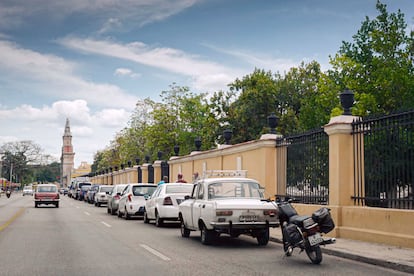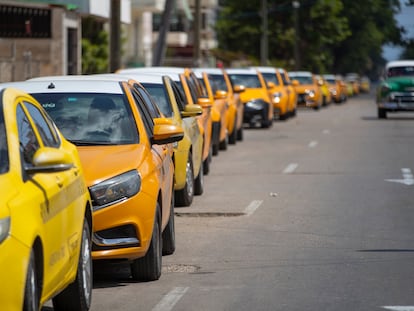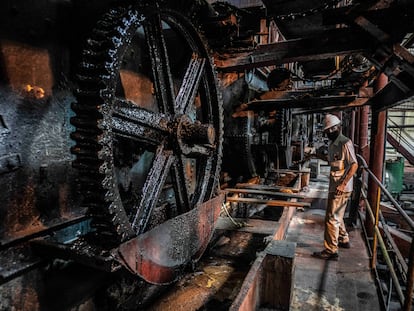Vietnamese cigarettes, diplomats squabbling over gasoline and surviving in Cuba with a sense of humor
The island’s energy minister reported that the improvement in fuel supply will not mean a return to levels seen in 2017, 2018 or even a few months ago

Dying with laughter, Lázaro shows up at home with a pack of menthol cigarettes in his hand. It is a green box of Tourane’s that says: “Produced in Vietnam by Vinataba Da Nang. For exclusive distribution in the Cuban market by Gran G S.R.L.” The added black and white warning to smokers is from the Cuban Ministry of Public Health: “Think before you light up, for your own good and your family’s.” Given the country’s perennial dire straits, Lázaro speaks in double entendres: “We should have thought that through.”
He goes on, cackling loudly, which startles the neighbors and my daughter. “Do you know how much this shit costs?” he asks rhetorically, and answers: “Well, 300 or 400 pesos, depending on the where you buy them, and the salary of a university professor is about 4,000 pesos a month. So we’re screwed: Vietnamese cigarettes in the land of tobacco!”
I let him go on, since he’s clearly fired up. “Cuba is also the country of coffee. And we, who taught the Vietnamese to plant it forty years ago, we produce almost none today, yet they are the second-largest coffee exporters in the world.”
I give him some rum, which calms him down a bit. We talk about the big issue of the day: the national fuel shortage. There is almost no diesel or gasoline anywhere. People have to wait in line for several days with no guarantee that they will be able to fill their tanks. It’s the same scenario all across the country: most service stations are empty, and those that do have a small gas pump are surrounded by miles-long lines of vehicles. “It’s like a post-apocalyptic landscape. The streets are half-empty on workdays, as if it were a weekend,” says Lázaro, who doesn’t own a car, but says that that doesn’t matter.
“When fuel is short, buses can take hours to come, and the few cabs that are still on the road charge whatever they want,” he says, giving himself as an example. Traveling from Centro Habana neighborhood to Miramar, a journey that normally takes half an hour, now takes almost two. “Something ain’t right,” he jokes.
The severe fuel shortages are worrying. They affect everything and everyone, and they are causing tense and sometimes surreal scenes. As there is so little fuel to be had, people make phantom queues, just in case. And when a tanker leaves the refinery, the authorities keep quiet about where it is going, to prevent would-be black marketeers from finding the fuel and selling it. My friend explains that the drivers made chat groups on social media, and they tell each other where the gasoline is or where it’s going to be. In one group, a driver reported in real time early one morning: “I am following a tanker truck... It is coming down Paseo Street, I think it is going to Paseo and Malecón. No, no, no... He has taken Third Street, he is going to the Puente de Hierro...”
As gasoline and diesel are distributed in dribs and drabs, the state has set up some service stations for the exclusive use of diplomats, others for cars used for tourism, others for foreign companies, and so on. There are fewer lines at these gas stations, but incidents still occur. In one infamous scene last week, a Russian had “made a reservation” in a diplomatic queue for dozens of consular cars. Drivers from other embassies began to protest and even the police had to come, but the Russian continued to argue that he had the right, since “that oil” had been sent by Moscow.
“The newest thing now,” says Lázaro laughing, “is that they are stealing license plates to put on private cars and refuel.” At this point, no one knows what is true and what is not, or if it is just Lázaro’s twisted imagination. Worst of all, perhaps, is the lack of official information.
We have been dealing with these shortages for more than two weeks, and so far the Cuban president, Miguel Díaz-Canel, has only said that the situation was “complex” and that it was not known when things would normalize. He explained that the country was consuming between 500 and 600 tons of fuel daily and that at the moment there were approximately 400 tons available for all activities (including transport and the general economy).
When Lázaro returned home after a few too many drinks on Monday, the Minister of Energy and Mines Vicente de la O finally appeared on Cuban TV news. He explained that the shortages are due to breaches in compliance by the supplying countries and the omnipresent U.S. blockade, and that because of this “the decision was made to distribute fuel in reduced capacities.” He added: “During the remaining days of April, we will continue to make available a reduced quantity of fuel, which is the reason for the lines at the service centers. The situation is improving as a result of decisions and negotiations, and suppliers are already meeting their commitments. That is one of the reasons why this information has been delayed.”
De la O did not strike much hope. “Today we have an improvement, but that does not mean we will have fuel like we had in 2017, 2018 or a few months ago. That will not be the situation in the remaining days of April and May. We will continue to draw fuel partially, in a reduced manner so that the fuel supply does not reach zero and vital services can be guaranteed.”
Within seconds of the newscast ending, the phone rang. “You saw what I told you, Galician: you should have thought it through,” Lázaro’s hoarse voice says from the other end. And in the background I hear the sound of ice clinking in his glass of rum, which is expensive on the street, but at least there is still some.
Sign up for our weekly newsletter to get more English-language news coverage from EL PAÍS USA Edition
Tu suscripción se está usando en otro dispositivo
¿Quieres añadir otro usuario a tu suscripción?
Si continúas leyendo en este dispositivo, no se podrá leer en el otro.
FlechaTu suscripción se está usando en otro dispositivo y solo puedes acceder a EL PAÍS desde un dispositivo a la vez.
Si quieres compartir tu cuenta, cambia tu suscripción a la modalidad Premium, así podrás añadir otro usuario. Cada uno accederá con su propia cuenta de email, lo que os permitirá personalizar vuestra experiencia en EL PAÍS.
¿Tienes una suscripción de empresa? Accede aquí para contratar más cuentas.
En el caso de no saber quién está usando tu cuenta, te recomendamos cambiar tu contraseña aquí.
Si decides continuar compartiendo tu cuenta, este mensaje se mostrará en tu dispositivo y en el de la otra persona que está usando tu cuenta de forma indefinida, afectando a tu experiencia de lectura. Puedes consultar aquí los términos y condiciones de la suscripción digital.
More information
Archived In
Últimas noticias
Most viewed
- Sinaloa Cartel war is taking its toll on Los Chapitos
- Oona Chaplin: ‘I told James Cameron that I was living in a treehouse and starting a permaculture project with a friend’
- Reinhard Genzel, Nobel laureate in physics: ‘One-minute videos will never give you the truth’
- Why the price of coffee has skyrocketed: from Brazilian plantations to specialty coffee houses
- Silver prices are going crazy: This is what’s fueling the rally










































